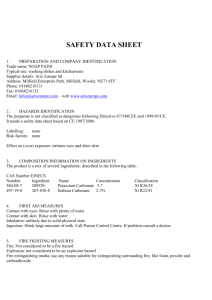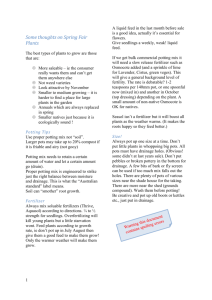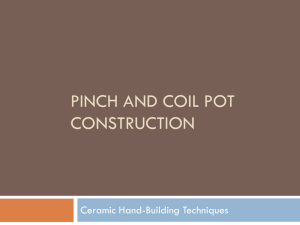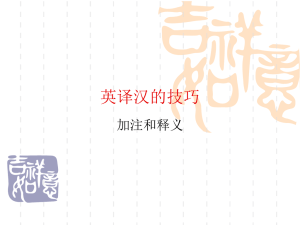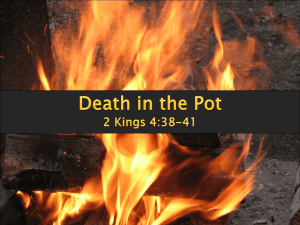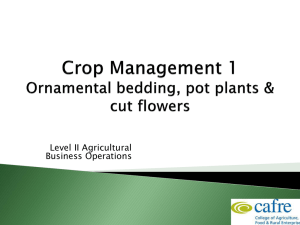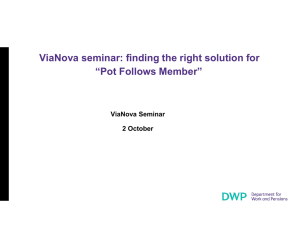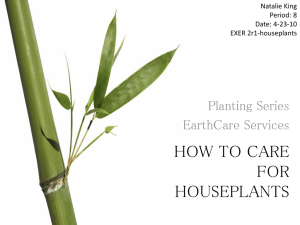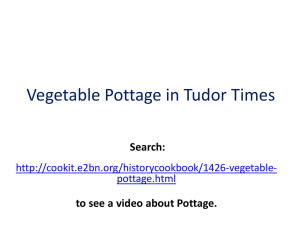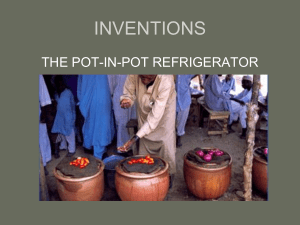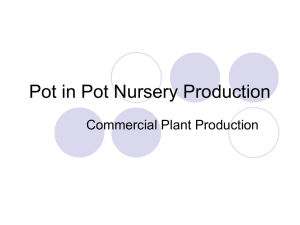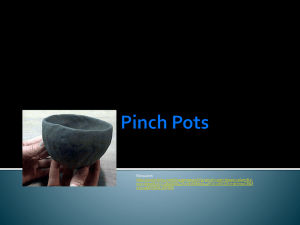Elaine`s presentation
advertisement
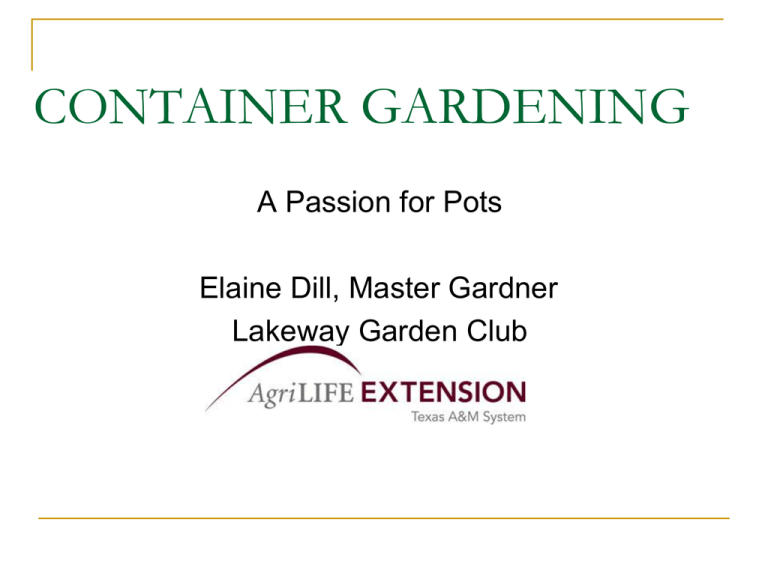
CONTAINER GARDENING A Passion for Pots Elaine Dill, Master Gardner Lakeway Garden Club Why Garden in Containers? No yard? No soil? Pets? Portability Neatness Accessibility No weeding Attractive Highlight or mitigate home or yard elements Selecting A Container Large enough for root mass of selected plants Good drainage Clay, wood, concrete, fiberglass, plastic, polycarbonate, styrofoam, hypertufa Use pot feet or other material to elevate pot off the ground Unusual containers Placement Sun or shade according to plant needs, avoid full sun Container size, weight, color & design Single pot or grouping Raise pot if necessary for visibility Accessibility of water Consider weight and drip pattern for hanging baskets Minimizing Water Loss & Heat Gain Use plant saucer to retain water, pebbles Mulch Light colored pots Clay, wood, fiber baskets hold less heat than ceramic or metal Insert one pot inside another Group containers so lower plants shade pots above Growing Medium Not garden soil! Drainage & aeration Hold moisture & nutrients Weed/pest free Lightweight Appropriate environment for different plant types Plant Selection Annuals – begonia, coleus, geranium, impatiens, nasturtium, pansy, pentas, petunia, zinnia, vines Perennials – daylily, dianthus, ferns, ornamental grasses, salvia, lantana, plumbago, verbena, roses, ivy Bulbs – canna, caladium, narcissus, elephant ears Plant Selection continued Herbs – chives, sage, mint, oregano, marjoram, parsley, thyme, basil Trees – fruit or ornamental, dwarf, slowgrowing Succulents – agave, aloe, euphorbia, sanseviera, hens & chicks Vegetables Light requirements: leafy greens need less sunlight than root or fruiting plants. Pot size: minimum for tomatoes is a 5-gallon pot (with attention to appropriate application of water & fertilizer), preferably larger. Plants which mature quickly make good container candidates. Combine vegetables and ornamentals. Maturity Dates Radish Mustard greens Lettuce Green onions Spinach Turnip greens Summer squash Kale/collards 21-24 days 30-35 days 40-50 days 45-50 days 45-50 days 40-50 days 45-55 days 50-60 days Suitability Scale Excellent: beets, carrots, cucumber, lettuce, mustard greens, green onions, pepper, radish, tomato Good: broccoli, brussels sprouts, cabbage, cauliflower, eggplant, potato, kale/collards, sweet potato, spinach, summer squash, swiss chard, turnip Design Elements Thriller – centerpiece, tall, season-long interest, sets tone for composition Filler – billowy, adds mass, grouping of 3, coordinates color & texture, hides bare knees of thriller Spiller – graceful droopers, softens edges, roots container to site, last piece of the puzzle Potting Cover drainage hole(s) with broken pot pieces. Do not add a layer or rocks or other medium. Mix pelletized time-release fertilizer at root zone in planting medium. Fill pot halfway with potting medium and add plants from the middle out. Fill in with potting medium to 1” from top of pot so that plants are at same level as in original pot. Water well; mulch if desired. Watering Amount depends on container, potting medium, temperature, wind. Use water wand or attachment on hose to soften impact & cover all surface area. Water from top of pot until water runs out bottom of pot. Frequency – check soil moisture (not just surface) before watering. Timing – early morning is best; in evening don’t wet foliage Drip irrigation – individual pot emitters Don’t use water from a water softener. Fertilizing At planting time add timed-release pellets to planting medium. Use higher nitrogen (2:1:1) initially to promote foliage growth. Maintain with lower nitrogen (1:2:1 or 1:2:2) water-soluble formula for flowering or fruiting plants. Don’t use dry granulated fertilizer which can burn plant roots. Fertilizing continued Organic nutrients – seaweed, fish emulsion, compost tea Foliar feed or drench Make concentrated stock to keep on hand. Water first; don’t add dry fertilizer to dry potting mix. Don’t foliar feed in hot sun or late evening. Maintenance Check containers frequently for soil moisture & drainage, weeds, pests, or diseases. Prune & deadhead plants appropriately to contain growth or promote flowering. Clean previously used containers with soap & water before replanting. Winter Care Wet pots can crack or chip in freezing weather. Roots can freeze even if plants are considered hardy when planted in the ground. Cover plants & entire pot with blankets or towels (plastic only second layer, no lollipops). Plants need less water & fertilizer. References Debra Lee Baldwin – Succulent Container Gardens Sam Cotner – Container Vegetables: The Easy Way to Garden Rob Proctor – Herbs in Pots, The Indoor Potted Bulb, The Outdoor Potted Bulb Sydney Eddison – Gardens to Go Joyce Fingerut & Rex Murfitt – Creating and Planting Garden Troughs Fine Gardening Magazine – Special Publications Byron Martin & Laurelyn Martin – Logee’s Greenhouses Spectacular Container Plants Ray Rogers – Pots in the Garden: Expert Design and Planting Techniques Paul Williams – Container Gardening: Creative Combinations for Real Gardeners Jim Wilson – Landscaping with Container Plants Travis County Master Gardeners Association Help Desk 512-854-9600 www.tcmastergardeners.org Daphne Richards Travis County Extension Agent - Horticulture
